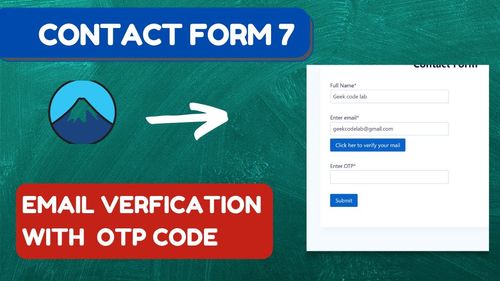In the dynamic realm of WordPress, Contact Form 7 stands tall as one of the most popular and versatile plugins for creating forms. Whether you're running a blog, an e-commerce site, or a corporate website, chances are you've encountered the need for robust email verification in your Contact Form 7. In this comprehensive guide, I, an expert in WordPress development, will take you on a journey through the world of email verification, explaining its significance and providing step-by-step instructions on how to implement it effectively.
Understanding the Importance of Email Verification
Email verification is a crucial component of any online form, including those created with Contact Form 7. Here's why it matters:
Enhanced User Experience: Verified emails reduce the risk of user errors and ensure seamless communication with your audience.
Spam Prevention: Email verification adds an extra layer of defense against spam submissions, protecting your inbox and database from junk data.
Data Accuracy: Verified emails result in more accurate user data, valuable for marketing and outreach.
Reduced Bounce Rates: Verified emails reduce the chances of email bounces, which can negatively impact your email deliverability.
Built-in Email Verification in Contact Form 7
Contact Form 7 offers a convenient way to implement basic email verification through its built-in features. Let's explore the steps to set it up:
Install and Activate Contact Form 7:
- If you haven't already, install and activate the Contact Form 7 plugin from the WordPress repository.
Create or Edit a Form:
- Navigate to the Contact > Contact Forms section in your WordPress dashboard.
- Select an existing form or create a new one.
Add Email Field:
- To include email verification, add an email field to your form using the "Email" tag.
Use Email Validator:
- In the "Email" field settings, you can enable the "Use Email Validation" option.
Customize Validation Messages:
- Customize the error messages that users will see if they enter an invalid email address.
Save Changes:
- Save your form and add it to your desired web page or post using the provided shortcode.
Advanced Email Verification Techniques
While the built-in email verification in Contact Form 7 is useful, advanced techniques can further improve your email validation process:
Regular Expressions: Customize email validation using regular expressions to match specific email patterns.
Third-party Plugins: Explore third-party plugins designed for email verification with Contact Form 7, such as the "Email Verification for Contact Form 7" plugin.
Custom JavaScript: Implement custom JavaScript to enhance user experience, providing real-time feedback on email validation.
Custom Email Verification for Contact Form 7
For those seeking more advanced email verification customization, consider the following steps:
Install a Custom Validation Plugin:
- Explore plugins like "Email Verification for Contact Form 7" to add additional email validation features.
Custom JavaScript Validation:
- Use JavaScript to create custom validation rules, enhancing the accuracy of email verification.
Integration with Email Verification Services:
- Integrate third-party email verification services to validate email addresses in real-time.
Common Questions About Email Verification for Contact Form 7
1. Is email verification necessary for every Contact Form 7 implementation?
- Email verification is recommended for forms that collect user email addresses. However, its necessity may vary based on the specific use case.
2. Can I customize the error messages for email validation in Contact Form 7?
- Yes, Contact Form 7 allows you to customize error messages to provide a better user experience.
3. Are there plugins available to enhance email verification in Contact Form 7?
- Yes, there are several plugins available that can add advanced email verification features to Contact Form 7.
4. How do I handle email verification for multi-step forms in Contact Form 7?
- Multi-step forms can also benefit from email verification. You can implement it similarly to single-step forms, customizing validation rules as needed.
In conclusion, email verification is a critical component of Contact Form 7 in WordPress. By implementing the steps outlined in this comprehensive guide, you can enhance user experience, reduce spam, and ensure data accuracy in your forms. Whether you opt for built-in features or explore advanced techniques, mastering email verification in Contact Form 7 will undoubtedly benefit your WordPress website.



